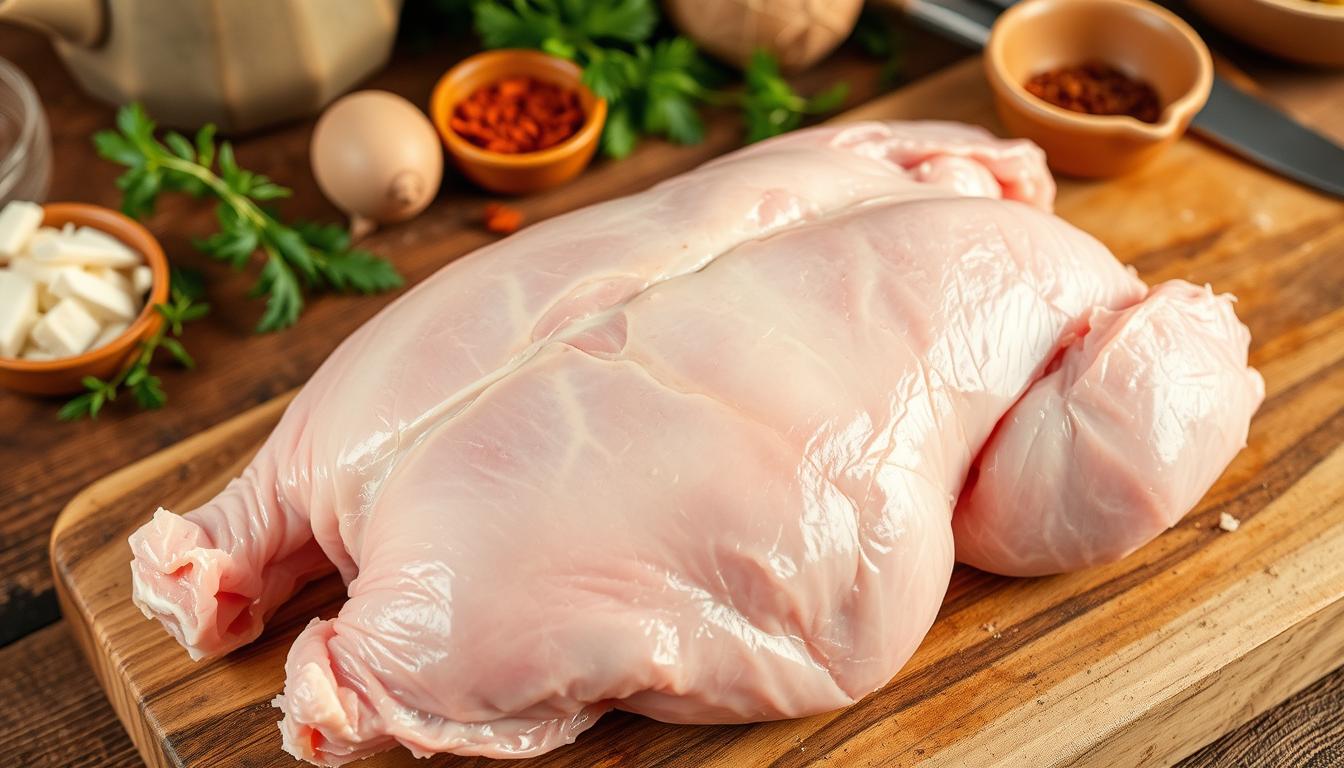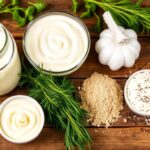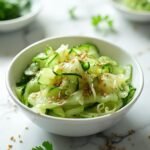Have you ever wondered if it’s okay to eat chicken veins? This concern pops up when you see bloody veins or pink meat. These visuals might make you question the meal’s safety, no matter the cooking approach. Whether grilling on a Weber kettle or spatchcocking, the method doesn’t affect vein safety.
- Understanding the Presence of Veins in Chicken
- Common Myths About Chicken Veins and Meat Quality
- Veins in Chicken: An Overview of Culinary and Health Perspectives
- The Role of Myoglobin in Meat Color and Perceived Safety
- “Veins in Chicken”: Dispelling Safety Concerns
- Cooking Techniques That Can Affect the Appearance of Chicken Veins
- The Science Behind Blood-Like Juices in Chicken
- Expert Advice on Managing the Aesthetics of Chicken Veins
- Nutritional Implications: Are Chicken Veins Healthy to Eat?
- Distinguishing Between Tendons and Veins in Chicken
- Conclusion
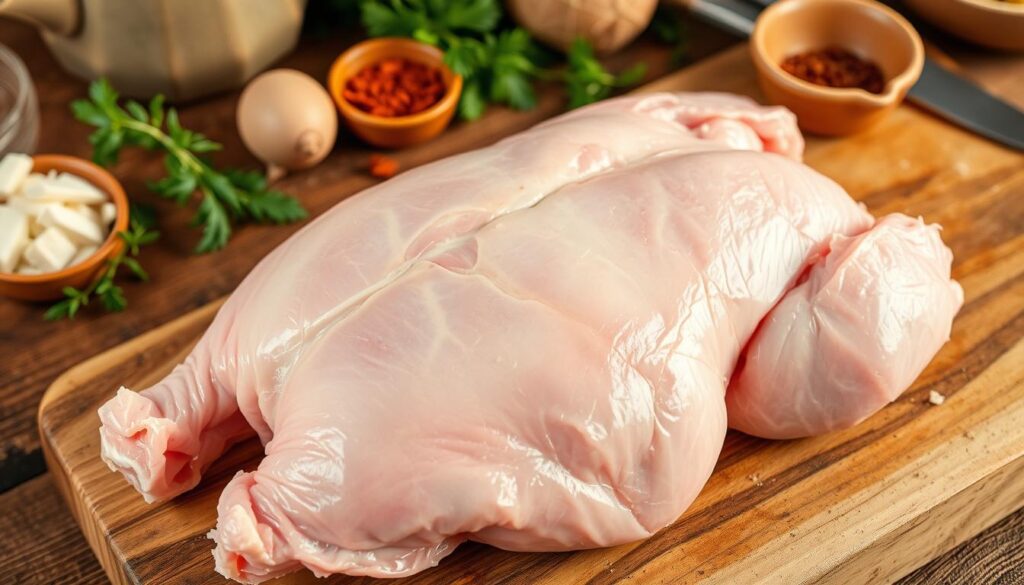
Let’s get to the bottom of this. The presence of pink shades or veins doesn’t decide if chicken is safe. What matters is reaching the right internal temperature when cooking—177°F for thighs and 169°F for breasts. Crispy skin or juicy meat doesn’t mean the veins are bad.
Key Takeaways
- Chicken veins are typically considered safe to eat when the chicken has reached the appropriate internal temperature.
- Most chickens in stores, aged six to eight weeks, have less blood, making veins less noticeable.
- The perfect chicken cooking temperature is 160ºF to 165ºF, regardless of vein visibility or meat color.
- The color of cooked chicken can change because of its pH level. This also affects when myoglobin loses its pink color.
- Smoking chicken might make it look pinker. But this doesn’t mean it’s not cooked properly.
- pH level differences can change the temperature needed for myoglobin to turn colorless. This can make chicken veins more visible.
Understanding the Presence of Veins in Chicken
When you cook chicken, it’s key to know about chicken anatomy, especially veins in poultry. Finding veins while cooking is normal, so no need to worry. These veins are crucial for the bird’s circulatory system. This system has arteries, veins, and capillaries that carry blood and nutrients all over.
When it comes to chicken preparation, seeing veins means nothing bad. It doesn’t mean the meat is undercooked or bad. It’s just part of the chicken that sometimes shows, depending on how you cook it. The important thing is cooking the chicken to the right temperature.
Chickens have a unique circulatory system that is vital for their health.
- Chickens have a high resting heart rate of 245 beats per minute and a blood pressure of 180/160 mmHg, different from humans.
- Their hearts pump more blood per minute for their size compared to mammals.
- They don’t have lymph nodes like mammals but have a system of small lymph vessels.
Veins in chicken show how efficient their circulation system is. Chickens have bigger hearts for their size compared to mammals. This difference is interesting given their different needs and ways of life.
| Feature | Description | Importance in Chicken Anatomy |
|---|---|---|
| Heart Rate | 245 beats per minute | Supports high metabolism and rapid circulation |
| Blood Pressure | 180/160 mmHg | Maintains blood flow across various altitudes |
| Heart and Ventricle Size | Larger relative to body size | Enhances blood delivery and efficiency in oxygen transport |
Knowing all this makes us better at chicken preparation. Understanding that seeing veins in poultry is normal helps us trust our cooking and safety practices more.
Common Myths About Chicken Veins and Meat Quality
There are many pink poultry myths and wrong ideas about poultry meat quality. Learning the truth is key to enjoying and safely preparing your chicken meals.
Myth 1: Pink Meat Indicates Undercooked Chicken
Many believe that pink chicken means it’s undercooked. But, cooked chicken can still look pink and be safe. The USDA confirms that chicken is safe at 165°F, no matter its color. AmazingRibs.com also shows color isn’t a reliable doneness indicator.
Myth 2: Blood Presence in Veins Means Unsafe Meat
Some think if they see blood in chicken veins, the meat is bad. But, most blood is taken out during processing. The red or pink liquid you see is mostly water and myoglobin, not blood. This shows that visible blood isn’t a sign of bad meat.
People worried about poultry meat quality misconceptions tend to spend more on “hormone-free” labels. They think it makes chicken safer or better. But, using hormones in poultry is banned in the U.S. So, these practices don’t affect chicken quality as much as some believe.
| Factor | Impact on Poultry Quality | Common Misconception |
|---|---|---|
| Hormone Use | Illegal in the U.S., thus not a factor | Poultry with hormones is unsafe |
| Meat Color | Does not necessarily indicate doneness or safety | Pink meat means undercooked |
| Blood in Veins | Mostly removed during processing, residues non-harmful | Visible blood means contaminated |
Veins in Chicken: An Overview of Culinary and Health Perspectives
It’s key to know the role of health safety of chicken veins in foods like chicken nuggets. Not every chicken nugget is all meat. For example, a study in Jackson, Mississippi found a nugget that was about 50% muscle. The rest was fat, veins, and more. This shows how the look and makeup of chicken items can change a lot.
Regarding cooking chicken veins, cooks often miss how these parts affect a dish’s nutrition and flavor. Chicken veins are safe to eat but not everyone likes to see or taste them. Knowing they are in some meats helps us choose what we eat wisely.
The National Chicken Council admits nuggets have mixed parts but still offer good protein. They suggest we weigh the pros and cons when eating processed chicken. This is crucial for understanding the health safety of chicken veins.
From 2000 to 2018, poultry meat production jumped by 47%, hitting 119.7 million tonnes in 2018. People around the globe are eating more poultry, making it vital in our diets. Knowing what’s in these products helps us make healthier choices.
| Content Type | Percentage | Description |
|---|---|---|
| White muscle tissue | 50% | Primary edible part of chicken, containing proteins. |
| Fat and other elements | 50% | Includes fat, blood vessels, nerves, and cells lining the skin and internal organs. |
| Protein level in nuggets | Varies | Despite varied ingredients, still offers significant protein. |
Learning about chicken products and their effects on cooking and diet is helpful. It prepares us to set the right expectations for different chicken meals.
The Role of Myoglobin in Meat Color and Perceived Safety
Myoglobin’s impact on chicken significantly affects meat color and how we see poultry’s freshness. It’s key to know this protein’s role. This helps clear up wrong ideas about meat safety. It also shows us the biochemical things that change meat’s quality.
What is Myoglobin and How Does It Affect Chicken Color?
Myoglobin is a protein found a lot in muscles. It’s important for carrying oxygen in muscle cells. For chickens, myoglobin’s state changes the meat’s color. The reaction of myoglobin to oxygen causes these color changes. This gives meat its unique look.
| Myoglobin State | Color Representation | Absorption Peak (nm) |
|---|---|---|
| Deoxymyoglobin (DeoxyMb) | Purplish-red | 557 |
| Oxymyoglobin (OxyMb) | Bright cherry-red | 525 |
| Carboxymyoglobin (COMb) | Bright red | 525 |
| Metmyoglobin (MetMb) | Brown | 503 |
Correlation Between Myoglobin and Meat Freshness
Myoglobin in chicken influences meat’s color. Yet, color doesn’t always show if poultry is fresh. Color changes happen more from contact with air and how meat is processed. They don’t mean the meat has spoiled. For example, fresh meat that’s bright red turns brown in the air. But this doesn’t mean it’s not fresh or good anymore.
The meat industry loses a lot of money due to discoloration. These losses can be more than one billion dollars each year. Handling meat correctly and teaching people about myoglobin can help avoid these losses.

How we cook can also affect myoglobin and the meat’s quality. Using careful heating methods can keep or boost good traits linked with myoglobin. Combining microwave and steam heating can prevent red spots. It also makes sure the meat colors evenly without losing moisture or nutrients.
Knowing about myoglobin and how it changes meat color helps us keep chickens fresh. It also makes sure people are happy with what they buy.
“Veins in Chicken”: Dispelling Safety Concerns
When we talk about chicken veins safety concerns, clearing up common misconceptions about chicken veins is crucial. Even though the sight of veins can make some people uneasy, they are perfectly safe to eat. These veins are mainly made of harmless connective tissues and collagen.
In chicken, particularly tender cuts like tenderloins, veins may appear whitish and stringy. How visible they are can change depending on the chicken’s breed and how the meat was processed. Despite being visible, these veins do not mean the meat is of poor quality or unsafe. They have beneficial nutrients, such as protein, that support muscle growth, joint health, and skin elasticity.
Furthermore, veins in chicken don’t make the meat less safe. What’s important for safety is cooking the chicken until it reaches the right internal temperature. This ensures the dish is safe to eat whether or not the veins are there.
- During cooking, the collagen in veins turns into gelatin. This boosts the meat’s flavor and juiciness.
- Choosing to remove veins is more about texture preference, not health.
- Some experts note that keeping the veins can help the chicken stay moist. This makes the meat tenderer and tastier.
Whether to eat or remove the veins often comes down to individual choice, not the need for safety. Yet, learning about the benefits and safety of chicken veins can shift views and ease chicken veins’ safety concerns.
In the end, people might have different tastes in chicken’s texture and look, but the safety of eating chicken veins is clear. Breaking the misconceptions about chicken veins and recognizing their advantages can make eating chicken a better experience.
Cooking Techniques That Can Affect the Appearance of Chicken Veins
When cooking chicken, the methods you use can change how it looks and tastes. Some techniques leave the chicken soft and juicy. Others might make the veins stand out or leave the meat pink. It’s important to follow food safety rules to make sure the chicken is safe to eat while keeping it juicy and addressing any pink meat worries.
Low-Temperature Cooking and Pink Meat
Chicken might look pink after cooking at low temperatures, like smoking or slow baking. This is because of myoglobin, a protein that stays pink under gentle heat. Young chickens often show this more because of their bone structure. But if you check the chicken’s internal temperature with a thermometer and it’s at least 71°C (160°F), it’s safe to eat despite the pink color.
High-Temperature Cooking and Juiciness Retention
For juicy chicken, try high-heat methods like grilling or searing. These ways of cooking lock in the moisture and flavor. Yet, be careful not to overcook it, as the meat can become tough. The perfect internal temperature is about 75°C (167°F), not more for too long. Letting the chicken rest after cooking also helps spread the juices inside, making it even tastier.
By choosing the right cooking methods and following temperature guides, we can solve problems like pink meat or visible veins. Sticking to these tips means each chicken dish will be both delicious and safe.
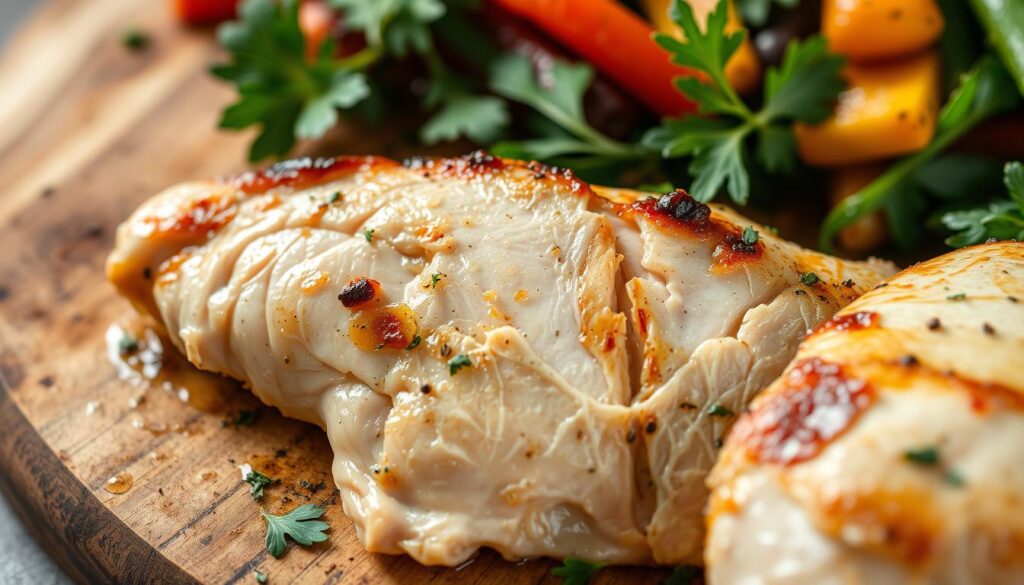
The Science Behind Blood-Like Juices in Chicken
Many home cooks often misunderstand the blood-like appearance in chicken. It looks scary but isn’t what you might think. This common kitchen issue comes from chicken juice science, focusing on myoglobin. The reddish juice from your cooked chicken isn’t blood. It’s myoglobin mixed with water.
Research shows that myoglobin levels in chicken change due to age and diet. Blood stops moving and hemoglobin is mostly removed once a chicken is slaughtered. But, the meat still has myoglobin, which turns red when cooked.
The USDA explains that the red liquid in packaged chicken is mostly water. This water is absorbed during the cooling process at production sites. Brining, a method the USDA recommends, pulls out myoglobin. This makes the meat tastier and safe to eat at 165 degrees Fahrenheit.
Adding things like turmeric and cayenne pepper can greatly change how meat looks. Studies show these additives can make chicken more nutritionally beneficial and help them grow better.
Understanding this science helps to know the blood-like appearance in chicken is normal and safe. It’s all about the meat’s chemistry and processing. There are various ways to fix this. Each one makes sure the chicken we eat is yummy and safe, all thanks to chicken juice science.
So, if you see pinkish juice in your pan, don’t worry. It’s a perfectly normal thing when cooking chicken. It’s supported by science and cooking experts. Enjoy your chicken without any concerns!
Expert Advice on Managing the Aesthetics of Chicken Veins
Making your poultry dishes look good is key today. Improving chicken aesthetics matters now more than ever. This guide will help you make your dishes look and taste better, focusing on chicken preparation techniques like deboning and using chicken marinades to improve how chicken meat looks.
Deboning for a Cleaner Presentation
Deboning chicken makes it look better. It’s advised to get rid of bones and veins for a nicer presentation. With care, you can get meat that looks smooth and perfect for fancy meals. But, you’ll need to know chicken anatomy well. This way, the meat stays in good shape.
Using Marinades to Alter Meat Coloration
Using chicken marinades is also great for improving how chicken looks. Adding things like citrus or vinegar does more than make the meat tender. It also changes the color of the meat, making it more appealing. This way, more people will enjoy how the chicken looks and tastes, making meals better.
| Component | Role in Chicken Preparation | Benefits |
|---|---|---|
| Citrus in Marinades | Reduces myoglobin, tenderizes | Lighter meat color, improved texture |
| Vinegar in Marinades | Breaks down proteins | Enhances flavor, reduces cooking time |
| Deboning Techniques | Removal of bones and visible veins | Cleaner meat presentation |
In the end, tips on chicken preparation like deboning and using marinades help in making chicken look better. These techniques make sure the chicken appeals to the eye and taste buds, which is important for any chef.
Nutritional Implications: Are Chicken Veins Healthy to Eat?
When talking about the nutritional value of chicken veins and chicken veins’ health implications, we must look at the whole picture. Chicken is a key protein source. Americans eat, on average, more than 98 pounds of it per year. It includes different parts, each with unique nutritional values.
Chicken veins are often overlooked when we eat chicken. They are made mostly of collagen and elastin. These are part of the circulatory system. Though not rich in nutrients, veins do not lessen the protein you get from chicken.
A single chicken breast gives you 33 grams of protein. It also provides 10% of your daily magnesium needs. These facts are key in looking at the nutritional worth of chicken veins. The presence of veins doesn’t affect these nutritional benefits. The huge amount of chicken we eat and process shows why it’s vital to know about every part of the chicken. This includes understanding the health implications of chicken veins.
Veins are safe to eat and don’t decrease the health perks of chicken. But, it’s good to stay informed about what we eat. For example, we should avoid fast-food chicken nuggets. They often have less healthy parts like blood vessels and connective tissues.
In short, chicken veins don’t pack a big nutritional punch on their own. Yet, eating them with the rest of the chicken doesn’t take away from the meat’s benefits. Chicken, with veins included, can be part of a healthy, protein-rich diet.
Distinguishing Between Tendons and Veins in Chicken
Understanding the difference between tendons and veins in chicken is key. Tendons are visible as white, stringy tissues. Their role in cooking and eating is big.
Identifying All Connective Tissues in Chicken
Chicken’s connective tissues include tendons and ligaments, made mostly of collagen. This protein can be tough when cooked. Veins, part of the bird’s blood system, are safe to eat and less noticeable after cooking.
Tendons are easy to spot in chicken breast, where they join muscle to bone. The tenderloin of the breast often shows the tendon as a white string.
Removal Techniques and Cooking Preferences
Whether to remove chicken tendons is up to you and how you like your food’s texture. Removing them can make eating more enjoyable by getting rid of chewy parts. You can use a paper towel and a sharp knife for a good grip and precise cutting.
- Using a paper towel and knife provides a good grip and control.
- Scraping with a knife under the tendon is efficient for quick removal.
- Employing kitchen pliers offers precision, particularly useful when dealing with smaller or slippery tendons.
It’s good to know that both tendons and veins in chicken are safe to eat. How you cook can make these tissues more tender. Slow cooking, for example, can turn the collagen in tendons softer and pleasant to eat.
In summary, knowing about chicken tendons and veins—or whether to remove tendons—helps make your meals safe and enjoyable.
Conclusion
We looked closely at the science and myths about chicken meat’s veins, important for both buyers and chefs. Many Primordial Germ Cells (PGCs) are found in the sinus terminals. They use anterior vitelline veins for moving at stages HH12-HH14. This shows veins are a normal part of chicken embryo development. The role of these veins in moving PGCs highlights their natural spot in chicken anatomy. So, veins are normal and not a safety risk when eating chicken meat.
Talking about cooking chicken, the look of the veins doesn’t determine meat quality or safety. The key is cooking it at the right temperatures. This makes the meat safe and tasty. Looking at the journey of PGCs and structures like the right hepatic portal vein, we see chicken veins as harmless for health and nutrition.
To end, chicken is a key food worldwide, rich in protein. Cooking methods or changing the meat’s look with marinades don’t affect its nutrition. The studies of chicken embryology and how we eat chicken prove that veins, though visible to some, don’t make the meat unsafe, less nutritious, or less tasty when cooked right.


